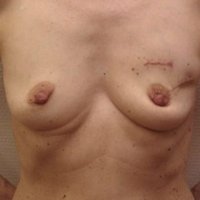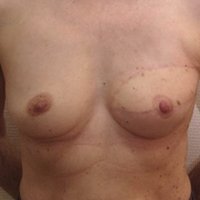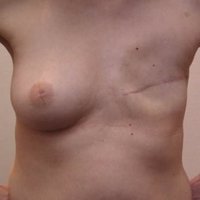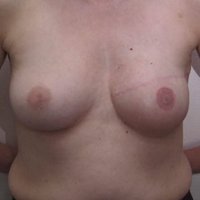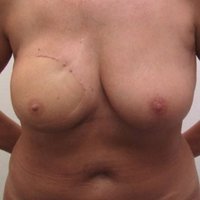Mammary Reconstruction after Mastectomy (ablation of the breast)
A breast reconstruction after a mastectomy (ablation of the breast) due to cancer can be done immediately (during the same surgery), after a few months or after a few years. With regard to the cancer, scientific research has shown that an immediate reconstruction is as secure as a deferred or postponed procedure.
The following methods are the most used ones:
- Reconstruction with an expander, then implant (generally silicone)
- Reconstruction with skin transplantation from the back, and implant (generally silicone)
- Reconstruction with skin transplantation from the abdomen
1. Reconstruction with an expander, then implant (generally silicone)
The mastectomy scar is reopened if necessary. Then the expander is placed under the great sub pectoral muscle. (See below). After a few weeks (2-4) the expander is filled with a saline liquid (physiological water) until the desired volume is reached. A definitive implant will be put in place after a few months.
Disadvantages
- Requires a foreign object (an implant).
- Requires two surgeries
a) The set up of the expander
b) Replacement of the expander after the dilatation, by an implant. - More difficult if the patient underwent radiotherapy.
see also Breast augmentation
2. Reconstruction with skin transplantation from the back and implant (generally silicone)
This reconstruction method is intended for patients who have little soft tissue remaining after a mastectomy, and for patients who have had radiotherapy. A skin flap is taken based on the muscle of the back and transferred into the area of the mastectomy. To give volume, a silicon implant is put in place.
Advantages
- The reconstruction is done within one surgery (no expander required).
- The skin flap of the back is a secure flap.
- Can be used for thin patients
Disadvantages
- Relatively long procedure (3 to 4 hours).
- An implant is required.
- Additional scarring on the back.
3. Reconstruction with skin transplantation of the abdomen
If the patient has enough soft tissue in the area of the abdomen a TRAM (Tranverse Rectus Abdominis Muscle) reconstruction can be done.
Part of the skin and fat tissue in contact with the large muscle above the navel, will be taken and placed in the area of the missing breast.
The vasculatures, which supply the skin and fat tissue, must be well preserved. From all the breast reconstruction surgeries it is the most delicate and lengthy of all procedures.
Advantages
No implant required, improvement of the bodyline of patients with little abdominal fat (see abdominoplasty)
![[Translate to english:] Mammarekonstruktion](/fileadmin/_processed_/c/a/csm_mammarekonstruktion_1_be96c7b57c.jpg)
![[Translate to english:] Latissimus Dorsi](/fileadmin/_processed_/7/1/csm_latissimus_dorsi_1_1526da54e3.jpg)
